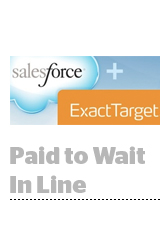 Memo to marketing industry observers waiting for ad tech to merge with marketing tech: It’s probably safe to go make popcorn, as this could take a while.
Memo to marketing industry observers waiting for ad tech to merge with marketing tech: It’s probably safe to go make popcorn, as this could take a while.
It’s been a year since Salesforce.com acquired ExactTarget. On Thursday, the company hosted a press event in San Francisco to commemorate the deal’s anniversary, using the occasion to show off some new capabilities in the ExactTarget Marketing Cloud.
Specifically, users of the ExactTarget Journey Builder can more easily map interactions with customers via a drag-and-drop interface, and they can set up a greater variety of real-time triggers to respond to user actions. These triggers can include abandoned site visits, abandoned shopping carts, affinity changes and myriad other events tracked within the Salesforce system.
But all the new triggers presented were for direct-messaging channels, such as email, SMS and in-app push notifications.
Cookie-based retargeting? No. Upselling through CRM-matched display media buys? No. Paid media of any kind? Not so much.
Of course, the ExactTarget Marketing Cloud does have a paid media capability, acquired two years ago through Buddy Media and its Brighter Option subsidiary (rebranded as Social.com). But that tool set remains relegated to social channels, in particular Facebook, Twitter and LinkedIn. Three big consumer platforms to be sure, but still representing a minority of desktop and mobile display ad space.
One Salesforce.com customer that’s enthused about ExactTarget Marketing Cloud is boutique hotel network Kimpton Hotel and Restaurant Group. The company launched a new loyalty program, Kimpton Karma Rewards, just 10 days ago to engage and retain the 1.5 million people in its database. It timed that launch to coincide with its new CRM platform and new website – all to more fully capitalize on what Salesforce has to offer.
“The previous CRM system was an archaic, non-cloud-based CRM platform,” said Maggie Lang, senior director of guest marketing at Kimpton. “It was a legacy system. Much of it had started breaking. There was no ability to connect with marketing automation.”
Kimpton decided to redesign its whole CRM and loyalty system around the customer experience. What it didn’t do was redesign its paid media strategy.
The company makes large investments in digital advertising to be sure, especially search and retargeting. It partners with Google and Adara on these initiatives, but those relationships are largely managed by Lang’s colleague. Paid advertising through Salesforce.com is not a focus.
“We’re extremely focused on retention vs. acquisition,” Lang said. “In terms of loyalty, we’re more interested in building deeper relationships with members than getting new ones. It’s very expensive to acquire a new member.”
Salesforce.com has a good story about its narrow focus (to date) on social paid media.
“We think of advertising in terms of identity,” said Scott McCorkle, CEO of Salesforce ExactTarget Marketing Cloud. “We have focused on the social ad world. People vs. cookies is a powerful [paradigm].”
Fair enough, but what about the larger sea of inventory out there, on platforms like Yahoo, Amazon and the hordes of mobile apps? And what about executing media buys across those inventory sources using a centralized data-decisioning engine?
McCorkle says Salesforce.com does have a data-management platform (DMP), though it doesn’t call it that, designed to wrangle a range of data sources.
“We’ve not positioned our AudienceBuilder product as a DMP in the ad tech world,” he said. “But it is a highly capable DMP. We are integrating point of sale, CRM, print and Facebook Custom Audiences data.”
What remains is to better execute media based on that data. The options are limited today, but the overall direction is clear.
“That ad tech and marketing tech are coming together is a trend worth noting,” McCorkle said. “Beyond our own consideration of that trend, we execute based on the customer. The road map is based on customer interactions and what we’re being asked to do.”
So hurry up and wait.













